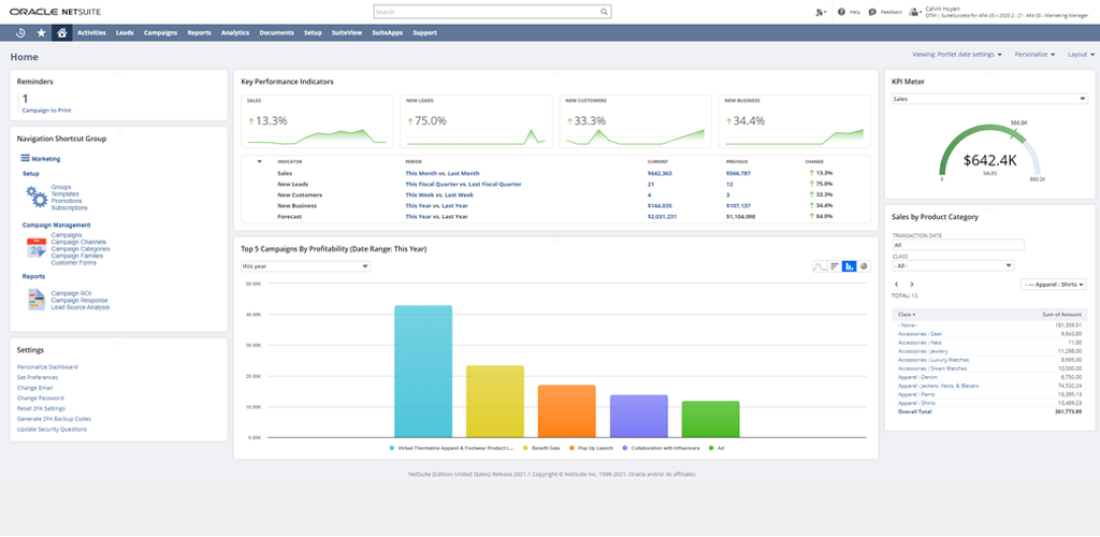In a continuing effort to shrug off their cost-center reputations, B2B marketing departments remain steadfast in proving their value. Key performance indicators (KPIs), which measure businesses’ progress toward meeting strategic and operational goals, go a long way toward demonstrating marketing effectiveness and justifying budget. KPIs — such as the number of marketing qualified leads, customer lifetime value and monthly recurring revenue by campaign — may even put an end (yes, please) to the retelling of the ol’ story about John Wanamaker, the Gilded Age department store mogul who once said, “Half the money I spend on advertising is wasted; the trouble is I don’t know which half.”
What Are B2B Marketing Metrics?
KPIs are concrete, quantifiable metrics that companies use to measure their performance, whether at the organizational level or for a specific department, such as marketing. Lagging KPIs look backward to track patterns and trends that have emerged over time, while leading KPIs measure activity that can help predict future outcomes. Hindsight being 20/20, lagging indicators are more precise, but leading indicators are more useful for planning.
Business-to-business (B2B) marketing metrics, in particular, gauge how well marketing initiatives are paving the way for bringing in new business customers and building existing client relationships into more profitable ones. Generally speaking, B2B marketing efforts typically focus on large deals with a small customer base and multiple decision-makers. KPIs that measure the quality of leads, the value of business relationships over time and how they contribute to growing the business tend to warrant prime focus.
Key Takeaways
- Digital marketing efforts figure prominently in many B2B marketing KPIs.
- Many B2B marketing KPIs revolve around leads — acquiring them, converting them to customers and monitoring all points in between.
- Other KPIs demonstrate marketing’s impact on a company’s bottom line, such as return on marketing investment.
- KPIs can also determine marketing channel effectiveness.
23 B2B Marketing KPIs to Measure
Measuring B2B marketing success requires choosing relevant KPIs that can be tracked consistently, in real time and, best-case scenario, automatically with software. Frequent monitoring is also important to ensure that performance is going in the right direction and, if not, to inform when adjustments need to be made.
What KPIs should B2B marketers track? That will depend on the business and its industry, of course, but the following 23 B2B marketing KPIs are a good place to start. And while industry benchmarks can be helpful for gaining a sense of how a business is performing compared to others, KPIs are generally most meaningful when viewed over time within the context of the business itself.
-
Website traffic: According to Gartner, B2B buyers spend more time online self-educating about possible purchases than on any other form of information-gathering, including meetings with suppliers. That’s just one important reason why B2B marketers are intent on driving traffic to their websites. While keeping in mind the possibility that a one-off event, such as a product launch, can temporarily skew traffic, KPIs that measure website traffic include:
- Visits: Each click on a web page.
- Unique visits: One visitor who clicks on one or more web pages in a visit.
- Page views: Total number of web pages viewed, including individually refreshed pages.
- Session duration: Average amount of time a visitor spends on a website.
- Bounce rate: How many website visitors click on one page and leave.
- Traffic source: Where website visitors come from, such as another site or email.
-
Source and medium: These KPIs work hand in hand. Source refers to a specific domain, such as LinkedIn.com, that sends traffic to a B2B company’s website. Medium describes whether the traffic comes from paid, organic or referral marketing efforts. Together, these KPIs show which channels and tactics, typically in combination, are bringing in the most visitors — read: potential prospects — and therefore may be worthy of future investment.
-
Website conversions by source: A website conversion occurs when a visitor performs a desired action on the site, such as downloading a report. The KPI becomes all the more valuable when viewed through the lens of which domains sent prospects to the website in the first place — information that’s useful to know for future marketing campaigns. The formula to calculate conversion rate for a given time period is:
Conversion rate by source =
(number of conversions by source / total number of visitors by source) x 100For example, if a content marketing article placed in LinkedIn results in 10,000 website visitors and 1,000 of them fill out a contact form, then its conversion rate, courtesy of LinkedIn, is 10%.
-
Marketing qualified leads (MQLs): In B2B, an MQL is a potential business customer that has shown interest in a product or service — perhaps by signing up for a webinar or newsletter — and is deemed worthwhile by marketing for the sales team to pursue.
-
Sales qualified opportunities (SQO): These B2B prospects have passed the sales team “test” as sales qualified leads (SQLs) and stand a strong chance of becoming customers. The ability to connect SQOs to marketing provides valuable insight into which methods are most effective, as well as marketing’s role in generating new business.
-
Top pages viewed by leads/MQLs/SQLs/customers: Tracking the most-viewed web pages within a website by type of visitor can help a business better understand a buyer’s journey and which products or services visitors are most interested in. This KPI can also inform content strategy. For example, which topics and content formats are most popular? For low-performing pages, should the content or page design be tweaked?
-
Cost per lead (CPL): Sales leads may be the name of the game, but no B2B marketer is granted an endless budget to reel them in. CPL measures the amount of marketing dollars it takes to acquire a potential customer, which, in turn, determines the cost efficiency of a marketing campaign. The formula to calculate CPL is straightforward:
Cost per lead = marketing spending total / new lead total
For example, if a company spends $50,000 in marketing during the third quarter and generates 500 leads during that time, then its cost per lead is $100.
-
Lead quality: Lead quality demonstrates marketing’s ability to target the right audience of buyers. One method to establish lead quality is (opens in a new tab)lead scoring, which assigns numeric scores to specific attributes, such as the prospect’s budget, the person’s level of authority in the organization and their readiness to buy. Leads with the highest scores will generally be prioritized. Another approach to assessing lead quality is lead mapping, which establishes how far a potential customer is along the decision-making journey; the farther along, the more likely they are ready to buy.
Lead quality can also be assessed by where the lead comes from. Leads coming through direct marketing (such as direct mail or email) are considered higher quality, since mailing lists have presumably been vetted. But leads coming in via a search engine, for example, will need to be qualified, since theoretically the visitor could be anyone — even the result of an accidental click.
-
Customer lifetime value (CLV): CLV measures the total amount of money a single business customer is forecast to spend with a company over the duration of the business relationship. The higher the CLV, the more revenue there is to be gained, so the more valuable the customer (financially speaking). Here is the formula to calculate CLV:
Customer lifetime value =
average transaction size x number of transactions x retention periodIf, for example, a customer with a three-year supply contract spends $10,000 on products each quarter of the year, then the CLV is $120,000 [($10,000 x 4 quarters) x 3 years = $120,000].
-
Traffic-to-lead ratio: This ratio, also called visitor-to-lead conversion or traffic conversion, measures the percentage of website visitors that become leads. The lower the ratio, the better, though what constitutes a “good” ratio will vary from business to business and activity to activity. To calculate the traffic-to-lead ratio, use this formula:
Traffic-to-lead ratio = total website visits / total new leads
For example, if a website has 10,000 total visitors in a month and marketing qualifies 2,000 of them, then its traffic-to-lead ratio is 5:1. In other words, for every five website visits, one results in a genuine lead.
-
Lead-to-conversion ratio: Also known as the lead-to-customer-conversion rate or sales conversion rate, the lead-to-conversion ratio measures the share of qualified B2B leads that eventually become customers. An important indicator of sales-funnel effectiveness, this KPI is typically calculated on a weekly or monthly basis by using this formula:
Lead-to-conversion ratio =
total number of qualified leads / number of qualified leads that resulted in salesContinuing the example above, if 200 of the 2,000 MQLs go on to become customers, the company’s lead-to-conversion ratio is 10:1. In other words, for every 10 leads, one becomes a new customer.
-
Form conversion rate: The form conversion rate KPI measures the percentage of website visitors that fills out and submits a form, which typically includes visitors’ contact information, title and basic company details. This action implies a level of interest, and possible lead, for sales to pursue. A low conversion rate may suggest an issue with the form, such as too many required fields or low placement on a page. Form conversion rate is expressed as a percentage and is calculated with a simple formula:
Form conversion rate = (total form conversions / total visitors) x 100
Let’s say 200 website visitors of a total 3,000 filled out a form to download a PDF with product specifications. The form conversion rate is 6.7%.
-
Cost per click (CPC): CPC, also known as pay per click, is a common online revenue model in which an advertiser pays a publisher each time someone clicks on its ad (up to a budgeted amount). The KPI monitors campaign performance and return on ad spend (more on that later). CPC is calculated with this formula:
Cost per click = total cost of ad clicked / total number of clicks
If the cost of a CPC ad campaign is $5,000 and 3,000 people clicked on it, its CPC would be $1.67.
-
Cost per action (CPA): Of course, a click may be just a click. With CPA, the advertiser pays the publisher each time someone takes a desired action, such as purchasing a product or service. CPA is calculated by dividing the cost of a campaign by prospect engagement:
Cost per action = total cost of campaign / total number of actions
If the $5,000 ad campaign led to the desired action of 250 sales, then the CPA is $20. In this case, the KPI is synonymous with another CPA, cost per acquisition, because the company gained a new customer.
-
Email open rate: Ever since the first blast went out in the late 1970s, email marketing remains a highly effective marketing channel among B2B marketers. Of course, the first challenge is getting recipients to open the message. The email open rate KPI is affected by a wide range of factors, including day and time the email is sent, subject line length and email frequency. Open rates are calculated with this formula:
Email open rate =
(number of emails opened / total number of emails delivered) x 100An email marketing message sent to 500 recipients, of which 150 open it, has a 30% email open rate.
-
Email clickthrough rate: This KPI measures the percentage of recipients who open the email, find something of interest and click on an embedded link that takes them to the company’s website so they can learn more. Use this formula to calculate email clickthrough rate:
Email clickthrough rate =
(number of email clicks / total number of emails delivered) x 100If 65 of the 500 email recipients click on a link within the message, then the email clickthrough rate is 13%.
-
Unsubscribe rate: This KPI tracks the percentage of email subscribers no longer interested in receiving a company’s email and who end their subscriptions. While there will always be some unsubscribers, an increasing rate over time suggests it’s time to analyze possible causes. To calculate the unsubscribe rate, use this formula:
Unsubscribe rate =
(total number of unsubscribe requests / total number of emails delivered) x 100If 30 of the 500 email recipients unsubscribe, then the unsubscribe rate is 6%.
-
Search rankings: Search engine optimization (SEO) is a keyword-based marketing method that influences placement — and, therefore, visibility — of items listed on a search engine results page. Simply put, the higher a B2B company appears on page 1 of a searcher’s results, the more likely it will be noticed and clicked on. Organic SEO (as opposed to paid placement) is based on ever-changing algorithm-driven factors, such as the ease of a website’s navigation, page load speed, the number of backlinks from other websites, content quality and use of images. Tracking this KPI over time shows whether marketers’ SEO techniques are working and driving website traffic.
-
Social media engagement: According to Gartner, 40% of B2B buyers turn to social media as part of their due diligence before making a purchasing decision — so it should come as no surprise that B2B marketers are allocating approximately 12% of their budgets to the channel. Audience interaction with a social media marketing campaign — in the form of shares, comments and clicks — is not only testament to a post or ad being noticed, but it can also organically increase brand mentions and boost visibility on social channels, thereby creating a bigger pool of potential leads.
-
Content marketing engagement: Content marketing — blogs, videos and podcasts, to name a few — delivers valuable information to customers and potential customers, creates brand awareness, brings in new leads, builds trust and plenty more. As with social media, audience engagement with content marketing, such as commenting on a post or clicking on a call-to-action button, implies a level of topical interest that could turn into an MQL.
-
Return on marketing investment (ROMI): ROMI compares the total cost of marketing to how much revenue and profit was generated. It can take weeks or months to generate, qualify, nurture and convert a B2B lead to a customer, so this KPI is best tracked over time. ROMI can not only demonstrate marketing’s contribution to the bottom line, but it can also justify marketing spend and future budget allocation. ROMI can be calculated with the following formula:
Return on marketing investment =
(net return on marketing investment / cost) x 100Net return on investment is calculated by subtracting the cost of a marketing initiative from total revenue generated. If a B2B marketing campaign cost $2,500 and resulted in $25,000 in sales, ROMI would be 900% [($25,000 – $2,500) / $2,500 x 100].
-
Return on ad spend (ROAS): Whereas ROMI measures the return on marketing investments overall, ROAS tracks the return on advertising expenditures specifically. This KPI can help B2B marketers identify which advertising channels and messaging tactics are most cost-effective and can also lead to insights gained from a less successful performance. The formula to calculate ROAS is an advertising-tailored version of ROMI:
Return on ad spend = (net return on spend / cost) x 100
-
Monthly recurring revenue (MRR) by campaign: MRR is the predictable amount of revenue a business receives from a customer each month, such as for a subscription-based service. By connecting a deal and its ensuing revenue to a specific B2B marketing campaign, a company can gauge the return on its efforts. Bigger picture, MRR can help predict cash flow and pinpoint other financial forecasts.
To calculate MRR, start with the average monthly revenue per account and then use that figure in this formula:
Monthly recurring revenue by campaign =
average revenue per account by campaign x total number of accountsFor example, if as the result of an email marketing campaign 100 companies subscribe to receive monthly shipments of office supplies at an average cost of $250 per month, then the MRR generated by that campaign is $25,000,000.
Tracking Marketing KPIs in Dashboards
With so many KPIs at their disposal, dashboards offer B2B marketers a convenient, at-a-glance way to monitor campaign performances in real time. Dashboards visually present marketing KPIs by displaying charts, tables, icons, meters and the like, all of which can be quickly interpreted and lead to faster decision-making. Dashboards can be created in spreadsheets — a labor-intensive approach, to say the least — and they’re typically included as part of leading enterprise resource management (ERP) and customer relationship management (CRM) software.

See Your Real-Time Marketing KPIs in a Single Place With NetSuite CRM
NetSuite Customer Relationship Management (CRM) is a one-stop cloud solution for marketing, sales and service teams, whose goals are inextricably linked. NetSuite CRM provides full visibility into a wide array of marketing KPIs that reflects how well the team’s campaigns are helping it meet its goals. Lead and sales activities are properly attributed to the marketing campaigns responsible for bringing them into the marketing and sales funnels. In addition, form information is captured and entered in real time, then routed to the right marketer or salesperson for the kind of quick response that improves lead conversion rates. Targeted marketing campaigns can be automatically deployed, managed and measured across multiple channels and touchpoints through the “magic” of marketing automation. Like so many NetSuite solutions, NetSuite CRM seamlessly integrates with NetSuite Enterprise Resource Planning (ERP) software, which manages companywide business processes from a single platform.
Successful B2B marketing teams use key performance indicators (KPIs) to measure the effectiveness of their campaigns and use subsequent data-driven insights as a guide for future activities. Marketing teams also use the information to amplify or tweak ongoing campaigns. Many B2B marketing KPIs revolve around acquiring new leads, getting those potential customers to take a desired action, such as filling out a web form or signing up for a newsletter, and converting those prospects into paying customers. And when wallets open, other KPIs, such as return on marketing investment and monthly recurring revenue by campaign, will speak for themselves.
3 Ways CRMs Deliver for Marketers

B2B Marketing KPI FAQs
How does B2B measure marketing performance?
B2B companies use key performance indicators (KPI) to measure marketing performance. Many use customer relationship management (CRM) software to track and display real-time KPIs on easy-to-read dashboards.
What are the most important metrics in a B2B marketing plan?
The most important metrics in a B2B marketing plan depend on a company’s strategic objectives and departmental goals. Return on marketing investment and customer lifetime value are two important high-level metrics. So is cost per lead and the lead-to-conversion ratio.
How often should KPIs be updated?
KPIs should be updated or changed whenever a business or department updates or changes its goals. Of course, KPI results can influence the business’s decision to amend its goals, provided that the KPIs reveal a trend over a period of time.
What are KPIs for B2B marketing?
Many B2B marketing KPIs focus on campaign performance. They include website conversations by source, cost per action, email open rate, social media engagement and search rankings.
How do you measure success of B2B marketing?
The ultimate success of B2B marketing is an activity that results in a sale. But success can also be measured by marketing’s ability to influence a prospect’s actions, even before they become a marketing qualified lead, such as by clicking on a social media ad.
What is the main KPI in social media for B2B companies?
Engagement is a key social media KPI, reflecting that people are interacting with an account or specific content. Engagement can be seen in the number of likes, shares, comments and clicks per post.
What are the 7 key performance indicators used in marketing?
Marketers use many KPIs to measure how well they’re meeting their goals. They may include return on marketing investment, website traffic, cost per lead, customer lifetime value, lead to conversion, email open rate and social media engagement.









